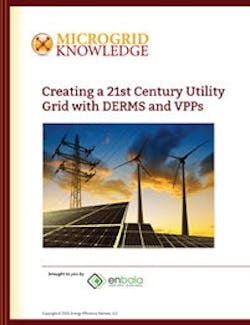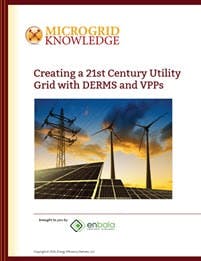The 21st Century Power Grid: Not Your Parents’ Power Grid
DERMs and VPPs — you hear the terms often now. They stand for distributed energy resource management systems (DERMS) and virtual power plants (VPPs), and they are remaking the electric grid as we know it. Learn more about DERMS and VPPs in our Microgrid Knowledge Special Report series. Here’s the first part, a discussion about what makes the 21st century power grid unique.
Download the full report.
Our power grids are changing, and they are changing very dramatically and rapidly.
A new solar installation goes live in the U.S. every 2.5 minutes. In fact, over a 14-day period in March 2017, California had so much solar power flowing to its grid that it paid Arizona to take excess power off its hands, fearing blackouts caused by overloaded power lines.
There are now more than 1,000 utility scale wind projects representing 84,405 megawatts and over 52,000 wind turbines installed across the U.S., and there are some 3.4 gigawatts of energy storage in the current global pipeline.
Add to that the other renewables on the rise — biomass, geothermal, hydropower — and then tack on flexible process load, fuel cells, combined heat and power (CHP), flywheels, electric vehicles, microgrids, demand response and still other DERs that are continually being added to our evolving power grids, and you begin to get a sense of how they are changing the fundamental physical and economic landscape of the utility industry.
The potential reliability, environmental, efficiency and economic benefits offered by successful integration of DERs into the energy mix have been well-documented. And as factors like lower costs, greater incentives and new corporate initiatives continue to drive growth of DERs, the opportunities continue to expand with each passing day.
There are challenges, however, with integrating this vast and growing mix of DERs into a power grid that was not designed for two-way power flows: challenges with managing these resources in a way that keeps the power grids in a perpetual state of balance.
DERMS and VPPs act as the platforms to manage a more DER-dominated grid via needed software.
“Think of VPPs and DERMS platforms as network orchestrators that control how and when each distributed energy asset contributes to a continuously balanced grid,” says Eric Young, vice president, industry solutions for Enbala, which, according to Navigant Research is the industry’s No. 1 provider of VPP software. “These software systems are the brains needed to bring the vision of a more sustainable energy future to life.”
“These software systems are the brains needed to bring the vision of a more sustainable energy future to life.” – Eric Young, Enbala
Given the importance of their role and their ubiquitous inevitability, it makes sense to take a close look at the criteria for VPP and DERMS effectiveness both today and into the future as the grid — and the mix of DERs on the grid — continues to evolve. Both control and manage DERs, but there are fundamental differences that warrant exploration and which impact the ROI and evolution of these systems.
Virtual power plants
Virtual power plants perform active power control across a fleet of assets to provide grid services that are independent of the specific location of each asset, for example feeders or circuits. In general, they provide system-wide benefits associated with increased or decreased generation or load and focus more on larger territories such as cities, counties, states or areas where independent system operators or regional transmission organizations operate.
Distributed energy resource management systems
DERMS, in contrast, provide grid services that are highly dependent on the specific location (grid connection) of each asset. DERMS-controlled grid services are delivered by manipulating power flows along individual feeders and include:
- Voltage management
- Optimal power flow
- Locational capacity relief
DERMS can manage both real power (watts) and reactive power (VAR), and can increase load on one part of a feeder while decreasing load — and increasing generation — at another part of the same feeder.
DERMS typically require more back-end system integrations than a VPP due to the requirement of locational grid and asset state information. For DERMS applications, integration with the utility is required, typically through a distribution management system (DMS), advanced distribution management system (ADMS), outage management system (OMS), or supervisory control and data acquisition (SCADA) system.
Why does this matter? Whether or not VPPs or DERMS are the optimal choice for a utility depends upon how the DERs will be used, and when. A VPP is probably the best choice for utilities that envision controlling edge devices for applications, demand response, energy arbitrage and peak demand management. A VPP can deliver significant benefits and meet near-term goals, while avoiding the larger up-front investment of integration with DMS, ADMS, OMS or SCADA systems.
A DERMS platform is needed for a utility with location-specific and distribution-focused applications, operating at a distribution feeder level to regulate grid conditions and better prevent system excursions, blackouts and power outages.
It’s important to note that a logical, phased approach that begins with a VPP and transitions to DERMS over time is entirely feasible and provides a logical path to follow as utilities gain more familiarity with real-time control and optimization of DERs and start to experience greater urgency for distribution-level grid balancing support.
“The foundation for a reliable, sustainable energy future rests on more distributed and intelligent networks of power,” notes Young. “DERMS and VPPs are the means to this end, enabling both the producers and consumers of energy to harness the power of distributed energy.”
The Microgrid Knowledge Special Report series will also cover the following topics over the coming weeks:
- Virtual Power Plants: Coming Soon to a Grid Near You
- DERMS: Next Generation Grid Management
- How DERMS and Smart Inverters Safely Bring Distributed Resources to the Grid
- Smoothing the Path for DER Orchestration: New Rules for a New World
- Blazing the Path from VPPs to Holistic Grid Control with DERMS
Download the full report, “Creating a 21st Century Utility Grid with DERMS and VPPs,” courtesy of Enbala, to learn more about how these tools and more are changing the face of the 21st century power grid.

